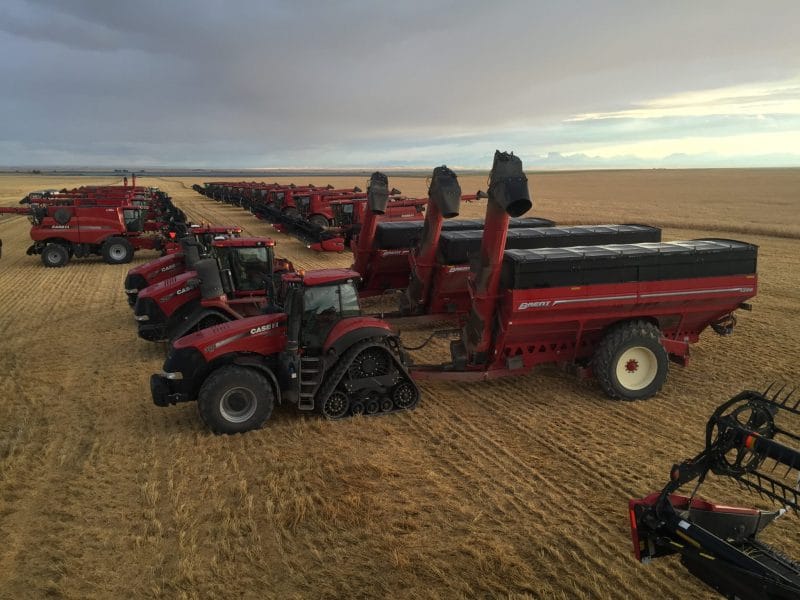Labour shortages are not new in agriculture. In the early 20thcentury, “harvest trains” travelled from east to west providing farm hands on threshing crews. Back then, you just needed a strong back and a willingness to work from dawn to dusk. Times have changed and a new labour shortage is looming, but now it isn’t a strong back that is needed, it’s a good understanding of technology.
A large-scale survey of the farming sector called Agriculture 2029: An Update on How Labour Challenges Will Shape the Future of Agricultureby the Canadian Agricultural Human Resources Council (CAHRC) determined the current 1,100 unfilled positions in grains and oilseeds cost Canadian farmers $594 million in lost sales or 2.6 per cent of all sales. “This is the largest loss of sales as a result of labour shortages in all of agriculture,” reports Debra Hauer of CAHRC. There were $2.9 billion in losses in agricultural sales across all sectors of agriculture, she adds, which is double that of 2014. “The reason the number is so high in grain and oilseeds is due to increased productivity and mechanization.”
While it is true more crops can be grown with fewer people to do the work thanks to larger equipment, technological advances, and the efficient use of herbicides, someone still needs to drive the combine, and it is helpful for another person to be there with a truck to empty the hopper. Smaller families and young people unable or unwilling to take over the farm, as well as the desire of the baby boom generation of farmers to retire, could mean a future with fewer people raised into the industry to do the work.
It isn’t easy to pluck someone from the city and give them a job driving the combine or operating the seeder, as modern equipment can look like the cockpit of an airliner requiring knowledge or training. In addition, wages can no longer be a minimum with an offer of room and board or a cot in the barn loft. In order to attract someone from the city to settle in a small town to work in the fields, growers need to pay competitive wages and, if possible, offer benefits.

Humphrey Banack is a grain grower and member of the Canadian Agricultural
Human Resources Council board of directors.
“Our grain farms are growing, and you end up with a business you cannot run by yourself,” says Humphrey Banack, a grain grower from Camrose and a member of the CAHRC board of directors. “From a seed growers’ perspective, you have to maintain quality and you need someone working for you who understands the importance of maintaining that quality. How can you expand your seed growing acres if you can’t find help to manage the expansion?”
Also aware of the labour shortages and how agriculture will be affected is the Royal Bank of Canada (RBC). The bank recently published Farmer 4.0, a comprehensive examination of the issue and an identification of how the industry needs to change to meet its future needs.
“Over the last two decades, agriculture has outpaced the rest of the economy with annual 5.5 per cent productivity gains, even as the sector has lost about one-third of its workforce,” explains Andrew Schrumm, senior research manager with RBC.
“In recent years, however, these gains have slowed to the national average. Looking to 2030, if we continue a downward slide, agriculture could drop to a 1.8 per cent productivity gain year over year. With these loses, compounded by mounting labour shortages, Canada could leave $11 billion in potential GDP on the table.” He adds that agriculture has been a standout over the years in learning how to use technology to replace people, but it is now clear the technology needs people to maintain and use it. What happens when the 37 per cent of farmers who have been using the technology and are eligible to retire at the end of 2020 leave the industry? Who will be trained and ready to take their places?
All the research points to a need to encourage young people to consider a career in agriculture. To do that, the industry must convince students interested in STEM (Science, Technology, Engineering and Mathematics) that agriculture offers satisfying and challenging careers. Across Canada, agricultural degree and college programs try to attract young people raised in cities to their programs because there are no longer enough rural youth to fill the classes.
“We have three generations working on our farm and each has a different perspective on our farm,” Banack explains. “Generations starting school today can expect to have three careers, not three jobs. So how do we change our recruitment process to attract people to agriculture who want a career? When I started farming, I just wanted to drive a tractor and now I’m a human resources manager. We need to learn how to recruit. Perhaps we need to study how other industries are recruiting.”
Understanding the technology used in a high clearance sprayer isn’t the only technology farmers need to master, according to Banack. He says growers need to tap into social media because a lot of job searches now happen that way.
He says if the industry wants to present itself as a viable career option, growers have to be willing to pay fairly. “It’s possible we might have to pay an employee more than we pay ourselves,” Banack continues. “We have to offer attractive wage packages.”
But paying more for help doesn’t answer the question of where to find the qualified people to do the work. On-the-job training is always a possibility if a grower can find someone who wants to learn, but it would be more time-efficient to be able to hire someone with the required skills who can step into a combine or sprayer and get to work.
“We’d like to see the federal government create a national skills strategy for agriculture,” says Schrumm. “We need to envision a long-term strategy to cultivate skills to attract young people to the industry.”
Hauer suggests apprenticeship and co-op programs could help fill the labour shortage. Giving students in agricultural programs opportunities to try their new skills and get paid for it might convince them that a career in agriculture offers fulfillment and a future.
Dale Steele of Steele Ag Insight in Lethbridge says he sees a disconnect between what is needed and getting it done. He has worked with Olds College and University of Alberta and he sees the labour shortage issue as multi-pronged.
“There are fewer farmers and fewer sons and daughters,” Steele says. “Enrolment by Canadians in agricultural programs is declining but foreign students are filling the spots. However, most of the foreign students are taking their learned knowledge back to their countries. How do we get non-farm people interested in working in agriculture? This industry leads in automation and technology, which should be attractive.”
Steele sees an immediate limitation in teaching the technology skills to fully utilize the computers and data that are part of all modern equipment. He suggests colleges and universities should explore curriculum changes to expose students to the new tools, technologies and digital agricultural platforms that are currently being used by farmers.
“Supply and demand should help solve the issue because high wages should encourage people to check out the skills needed,” Steele continues. “But how do we convince urban dwellers to move to underpopulated areas of the country in order to take a job operating a sprayer?”
Back to supply and demand, Steele says if the sprayer is worth $300/hr and it is sitting for lack of an operator, perhaps it makes sense to pay $30/hr to get someone to run it. “Universities and colleges should be training students in the latest technology, but I’m not seeing that.”
Schrumm agrees a long-term strategy needs to be put in place to attract young people to the industry. “We need to get away from agricultural stereotypes.”
Modern agriculture is vastly different than the style practiced when the harvest trains came west. Anyone working in agriculture today needs to “crunch numbers,” according to Schrumm, and that person needs to generate spread sheets to satisfy inspectors who are tracking food from seed to bread. Computer literacy is needed to operate high-tech equipment to manage GPS, precision application, and to manage storage systems to ensure temperature and moisture are maintained.
Hauer believes that agriculture, as always, will adapt, and will determine how to attract employees and will support outside training as needed. “Agricultural producers are extremely innovative,” she says. “Adaptation will continue.”
However, will the industry adapt quickly enough and be supported by colleges and universities to reduce the predicted labour shortage to a news headline and not a prolonged problem? Steele is concerned the lack of skilled labour for agriculture will become chronic.
“My kids are approaching their college or university years and there are no Canadian universities where they can learn about soils, plants, biology and business along with the basics of GIS, remote sensing and computer science in an agriculture program to prepare for the future,” he says. “Imagine if dentistry or medical students didn’t have access to the new tools and procedures used in their fields?”
Banack encourages growers to visit the CAHRC website to learn how to manage the labour issue. “We have to recognize there are changes happening and get involved now. The Alberta Federation of Agriculture is involved in labour laws, compensation packages and workers’ compensation. If we want to attract people, we have to provide safe workplaces.” He adds the CAHRC information can be used by colleges, universities and governments, not just farmers, to minimize labour shortages. Banack suggests a five-year plan could be developed and then acted on.
Schrumm agrees. He believes as farmers continue to evolve into agricultural business people, rather than sticking with the old stereotype of a traditional family farm, potential employees will begin to see agriculture as a technologically challenging career path. But growers will have to pay to get the best people and keep them, which could require, as Banack did, becoming a human resources manager along with being the technology manager, the chief financial officer, and the equipment mechanic.
In reality, farm operations and their managers will continue to be what they have always been — multi-dimensional businesses — but more emphasis will be placed on training employees or recruiting agriculture program graduates and then paying them fairly in order to keep them on the farm.
A Scholarly Approach to Labour Shortage
Most universities and colleges attempt to match their programming to the needs of industry, but Olds College is uniquely positioned to provide the programs that fit with agriculture.
According to James Benkie, the dean of program development for agricultural technology, the college is aware of the growing shortage of skilled labour. “At the very core of what we do, agriculture is still agriculture, but we’re doing it in different ways,” Benkie says.
He adds today’s students need to learn how to adapt to the rapid changes that affect the industry yearly. “We continue to gather information on future needs and translate this feedback into new courses, but we are really preparing students for jobs that may not exist — yet.”
Benkie says Olds College is trying to keep up with the labour needs of industry as it recognizes that as farming operations change, the style of decision-making is changing. The use of technology on farms requires someone adept at using technology and systems with the ability to learn and optimize how the changes will affect the farm operation. He says the college will teach the skills that will help students “move through the transitions in technology.”
“The value we can bring to an organization, when technology tends to have a short shelf life, is to teach our students to keep learning,” Benkie explains. To set students on the right path, the college has created some new credentialing programs — a one-year post-diploma certificate in agricultural technology integration and a two-year diploma in precision agriculture.
With a predicted labour shortage looming, Olds College is one institution that is trying to fill the void by graduating tech-savvy individuals to fill positions that will help growers keep their operations successful.








